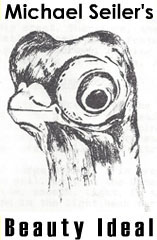This term “crawlers” is not my own. This word was coined by, the great short face breeder, Rudy Strnad back in the early 1970’s. He used the term to describe the movement of a very young unhealthy squab that would eventually die no matter how you attempted to save it. You would put a youngster under a pair of foster parents to be raised as one usually does and you would see the youngsters crawling out from under the adult bird. Sometimes you would witness the adult birds re-positioning themselves over the baby repeatedly. In the early spring the youngsters usually crawled out of the nest bowl to die from exposure. In the warm summer months you find the youngsters all over the nest box. For many years, we blamed those losses on the foster parents. It is not the foster parents!
How often do you say to yourself – if I only knew then, what I know today. Well better late than never. The root of this problem is the onset of a navel canker. The youngster is getting pressure on the digestive track and is starting to starve and the response is this “crawling.”
Even if you treat your flock for canker in the beginning of the breeding season, you will see this occur sometimes. You can cure this problem and save the youngsters if you work quickly. Fortunately, I do not see this problem as often as years ago. One in 30 youngsters might have this problem. If it occurs, all you have to do is take a Spartrix tablet (10 mg of Carnidazole) and dissolve it completely in warm water and administer it to the youngster. Ridzol is another very useful product for canker. I realized that these affected squabs are very small. Therefore, I suggest that you get a very small syringe and attach a cannula tubing to it with the leur lok head and draw up the solution (Spartrix, Ridzol S, metrodiazole dissolved in water) into it for easy insertion into the crop.
The cannula is a tube used to administer I.V. injections into a patient or large animal. I am sure that a doctor, nurse, or veterinarian can get you one. You don’t need the needle portion and if they cut off the needle you no longer have a problem with anyone accusing you of having a dangerous piece of medical equipment.
Spartrix and Ridzol S, in my opinion, are two of the finest medications on the market. These are rather reasonable and readily available. The tolerance of the birds is extremely good. You will not poison a little squab even with a whole tablet. The youngster will resume normal growth in a day or two. You may have to switch the youngster to another foster pair to get the additional pigeon milk it will need to stimulate growth again. You could, also, hand feed the youngster.
The reason that I addressed this topic is that for 50 plus years of raising pigeons I never saw this phenomenon in my long face youngsters. (Exact same loft conditions for both long face and short face). Only the short face youngsters exhibit this navel canker. I believe the reason for its occurrence to be two fold. 1) Many times we, as breeders, help short face youngsters from the egg and this leaves the navel wet and vulnerable to infection. 2) Nutrition plays an important role here as well. Short face youngsters never really get enough milk from their parents in the first two days because they are so small and their crops only have one third the volume of long face youngsters. Their genetic parents, also, never get the right nutrition from the food they manage to pick up either. This, of course, contributes to weaker youngsters.
Yes, the breeding of short face pigeons is an art and quite a challenge because they have been altered by breeders for almost 200 years. A little knowledge and experience goes a very long way.
